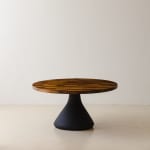









Jorge Zalszupin
H 76.5 cm x Ø 150 cm
Further images
-
(View a larger image of thumbnail 1
)

-
(View a larger image of thumbnail 2
)

-
(View a larger image of thumbnail 3
)

-
(View a larger image of thumbnail 4
)

-
(View a larger image of thumbnail 5
)

-
(View a larger image of thumbnail 6
)

-
(View a larger image of thumbnail 7
)

-
(View a larger image of thumbnail 8
)

-
(View a larger image of thumbnail 9
)

-
(View a larger image of thumbnail 10
)

The iconic Guaruja is a table designed by Jorge Zalszupin (1922-2020) in 1959 and produced by his company, L'atelier. The round Rosewood patchwork top rests over one concrete base finished with leather.
This solution was widely used by him and became one of his marks. It helped to solve several problems, such as reducing the waste of material; facilitating the process of covering large surfaces; smoothing the variations of the veneers that covered the same piece of furniture; and, finally, making the production costs cheaper.
As the Guanabara table, Guaruja was presented as a dynamic piece that could be used in corporate spaces (as a meeting table) and domestic places (as a dining table). Today, we still recognize its versatility, a mark of good design.